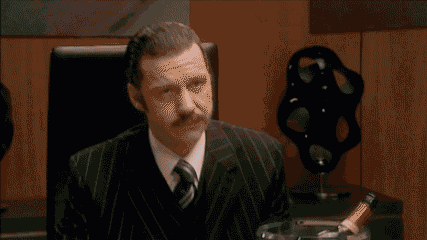It may qualify as a film due to definitions or whatever reason.
http://www.youtube.com/watch?v=7EluIdiuUuA
This however is not fluid in moition. Of course it's not real "stop motion" which is a method to animate lifeless objects. I did a stop motion movie once. Fun but veeeeeeeery tiring. Took forever to do a 15sec animation.
From WIkipedia:
"Thomas Edison said that 46 frames per second was the minimum need by the visual cortex: "Anything less will strain the eye."In the mid to late 1920s, the frame rate for silent films increased to between 20 and 26 FPS."
When sound film was introduced in 1926, variations in film speed were no longer tolerated as the human ear is more sensitive to changes in audio frequency. Many theaters had shown silent films at 22 to 26 FPS which is why 24 FPS was chosen for sound. From 1927 to 1930, as various studios updated equipment, the rate of 24 FPS became standard for 35 mm sound film. At 24 FPS the film travels through the projector at a rate of 456 millimetres (18.0 in) per second. This allowed for simple two-blade shutters to give a projected series of images at 48 per second, satisfying Edison's recommendation."
So okay. It was a mixture of taking a Edison recommendation and working around it with the technical limitations of the time. Other sources also talk of the trade off between quality and film cost.
I doubt Edisons "recommendation" had anything to do with it. Is that quote taken as a direct context to the standardization of 24fps?.
He was against talkies, remember? Father of the patent trolls, and credited as one of the biggest banes against movies in the beginning. He has a famous quote I remember hearing at film school about how he said he could see the acting being so much worse after films with sound became advent. Plus all the bullshit with Tesla. The movie industry hated him by the end, as he tried to sink the entire ship.
Maybe because not all actors are memorable? Just like you don't remember every actor from the 70s, every nfl player in history...? But the ones you mentioned are still remembered and beloved. So maybe it is because they were good and not the new technology? Good actors can adapt.
You seem very harsh in comparisons! I am saying that only a small handful of all the stars in Hollywood managed to make the transition from silent to sound. How can you even possible make an analogy of that, to remembering every actor from the 70s? That's not the same thing at all. Look - My entire point is just that, sound film with a technological leap steeped in the advancement of storytelling. It wasn't just fluff. The beneficial tools to help tell a story or create immersion was clear, and the difference was so vast that a lot the stars that were considered among the greatest of their time, couldn't adapt. Sure, good actors can adapt, but that's a very generalized broad strokes way of looking at the world, don't you think? Obviously there is more to it than that.
You know it's like a different field. It would be like saying that any chef who couldn't make the transition to become a good baker, was not a good chef, because good chefs can adapt. Everyone has varrying degrees to which they can adapt right?
If you haven't seen it Sunset Blv. is a great movie about a silent movie star lost in time. Like actors and actresses who were from a stage background, they had to act in a completely different way and didn't know how to competently use their voice, while their "over acting" with their facial features were too much for many films.
There are not many movies made in 48/60fps. But I know one thing. Watching the Hobbit was a great experience because you had no blur during camera panning. So you could admire the beautiful set pieces even more. Also action sequences filmed with a dolly cam where much easier to follow and not just a hectic and blurry mess. I am talking about the barrel scene in the second movie here. I think something like that is a very positive effect for people who watch the movie. It was very hard to follow to blurry, fast cut battles of LOTR without getting dizzy.
Vincent Laforet(from Gizmondo) had a great piece about this subject. He says it better than I can formulate it into words;
The reason the standard film projection rate of 24 frames per second works so well, is that it's just a few frames faster than what the brain needs in order to be tricked into seeing what are effectively still images, appear to move on screenit's called the "Persistence of Vision Theory." In tandem with that important theory, he motion blur you get by shooting at 24 fps and (on a standard 180 degree shutter) at 1/48th of a second, is just as important in making something look "cinematic" as the lack of depth of field we get by using larger sensors, and bright lenses at large apertures. This is precisely why one should shoot at 1/50th of a second on their HDSLRs and use ND or neutral density filters to makes sure they don't have too much depth of field and can also ensure they aren't forced into shooting at higher shutter speeds.
2) Yes, in some arbitrary way 60fps, looks more real, and it certainly has its value for what you are talking about in regards to action, sports and gameplay in games where you need clear visual stimuli to help processing what it is going on. But film is not about being real. It's about immersion, and a lot of people felt that the hobbit looks faked and staged. 24fps, ND filters, and post production cc help facilitate a different world that has nothing to do with real life. If you wanted to view films as real life everything would be shot with 60 fps home videocams because it would "look exactly like real life". That's a complete misunderstanding of what makes cinema great.
It seems you are talking about cutscenes ... but I don't play cutscenes. I have to control the gameplay. I have no problem with cutscenes being pictures ,24fps with black bars or just plain text (Max Payne 1 being a glorious example of great storytelling with still frames).
But in the end I have 10+ hours of gameplay. And this is what matters. Here I have to control the character from a fixed angle (behind the shoulder or even first person). I control the camera. I have to make split second decisions and coordinate eye and hand. Playing a game at 30fps with a mouse is terrible. This is not a movie where you lean back and watch it.
Hmm. Did you read my first post? My entire point was that gameplay should be 60 fps, while cut scenes 30. There shouldn't be a compromise between the two. Maybe you misunderstood what I was trying to say

And one last thing regarding the cutscenes: Even if the games have production values of film. Stories of this games often remember mindless blockbusters like Transformers. I don't see many games with high production values and great stories, memorable characters and stuff.
Be careful mate! Don't mix high production values with storytelling, quality of narrative, character development and so on.
High production value, is things like slick cinematography, slick CGI, animations, SFX, lighting and so on and whatever. So you are wrong if you think a lot of games don't have high production values. Many of the best selling video games, from GTA5 to the Last of Us are basically bathed in influences from high production values pioneered by hollywood.
Story, plot, characters and writing is a completely different matter, and for a different discussion. But of course I agree that this is the area which games are lacking. But even hollywood has been doing really poorly in later years, and as we have seen many of the great stories come from indie productions.

If there are mistakes in grammar or spelling. I'm sorry, but with english being my third language and the schooltime long forgotten ... you get the drill
Don't apologize. Same for me, plus I am heavily dyslexic so I know the feels.





